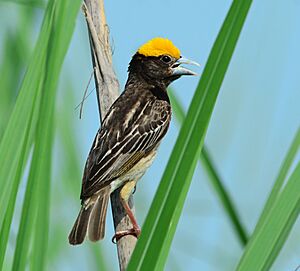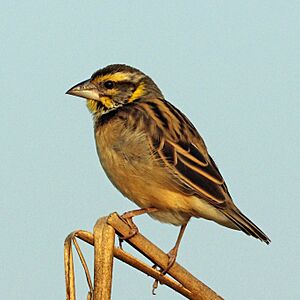Black-breasted weaver facts for kids
Quick facts for kids Black-breasted weaver |
|
|---|---|
 |
|
| Breeding male in northern India | |
 |
|
| Female or non-breeding male in Uttar Pradesh, India | |
| Conservation status | |
| Scientific classification | |
| Genus: |
Ploceus
|
| Species: |
benghalensis
|
| Synonyms | |
|
Loxia benghalensis Linnaeus, 1758 |
|
The black-breasted weaver (Ploceus benghalensis) is a small bird found in the northern parts of the Indian subcontinent. It's also known as the Bengal weaver or black-throated weaver. This bird belongs to a family called weavers. Like other weaver birds, the males are amazing builders! They create special enclosed nests using reeds and mud. Female weavers then choose their mate based on how well he built his nest.
Contents
Meet the Black-breasted Weaver
Who Discovered This Bird?
The black-breasted weaver was first officially described in 1758. A Swedish scientist named Carl Linnaeus gave it its scientific name. He wrote about it in his famous book, Systema Naturae. Linnaeus first put this bird in a group with crossbills. Later, in 1816, a French scientist named Georges Cuvier placed it in the Ploceus group. Today, the black-breasted weaver is one of 67 species in the Ploceus group.
What Does a Black-breasted Weaver Look Like?
The black-breasted weaver is about the size of a sparrow. It grows to be about 15 centimeters (6 inches) long.
When it's time to find a mate, the male bird looks very colorful. He has a bright golden-yellow cap on his head. His head and chest can have different amounts of black. Some males have an almost completely black head and chest. Others might have a white throat or a white face with a black band.
Female birds and males not looking for a mate look a bit different. Their heads are brown, like the rest of their upper feathers. The black band on their chest is also less noticeable. These birds also have pale yellow marks above their eyes and behind their ears.
You can often spot flocks of these birds. They like to hang out in farm fields. They also live near shallow lakes and areas with tall grass.
Where Do Black-breasted Weavers Live?
The black-breasted weaver lives only in South Asia. It is common in many parts of its home range. You can find it across the northern part of the Indian subcontinent. There are also smaller groups in the southern part of India.
People in different places have special names for this bird:
- In Hindi: Hindi: Sarbo baya
- In Bengali: Bengali: কালোবুক বাবুই (Kalo-buk babui), বাংলা বাবুই (Bangla babui), শর বাজা (Shor baJa), কান্তাওয়ালা বায়া (Kantawala baya)
How Do Black-breasted Weavers Behave?
Black-breasted weavers live in groups. One male bird often mates with several females. Their behavior is quite similar to other weaver birds, like the Baya weaver and streaked weaver.
Building Nests and Finding Mates
Black-breasted weavers build their nests between June and September. They often build nests in small groups of 4 or 5. Sometimes, they form larger groups, like a small village of nests!
The male bird does all the nest building by himself. When the nest is almost done, a group of female birds will come to visit. They will jump on the nest's top part, called the "helmet." They tug and test it to see how strong it is. This helps them decide if the male is a good builder.
If a female seems interested, the male will bow low to her. He shows off his golden crown. He flaps his wings slowly and sings a soft song. It sounds like a cricket chirping or a quiet squeak. If the female likes the nest and the male, she will allow him to mate with her.
Once they mate, the male quickly finishes the nest. The female then lays her 3 or 4 white eggs inside. After that, the male immediately starts building a second nest nearby. He hopes to attract another female. Sometimes, he might even build a third or fourth nest! If a female doesn't like a nest, the male might even tear it down himself.
The nests look a bit like those of the streaked weaver. They are usually a bit smaller. They also have shorter entrance tubes, about 25 centimeters (10 inches) long. These nests are built in marshy areas, often in tall reeds. The reeds are sometimes woven into the nest for extra support.
When the nest is at the "helmet" stage, the male adds a thick layer of wet mud or cow dung. He also adds bright scarlet or orange flowers or petals. Scientists think this is part of his courtship dance. It seems to help impress the female birds!
Images for kids




